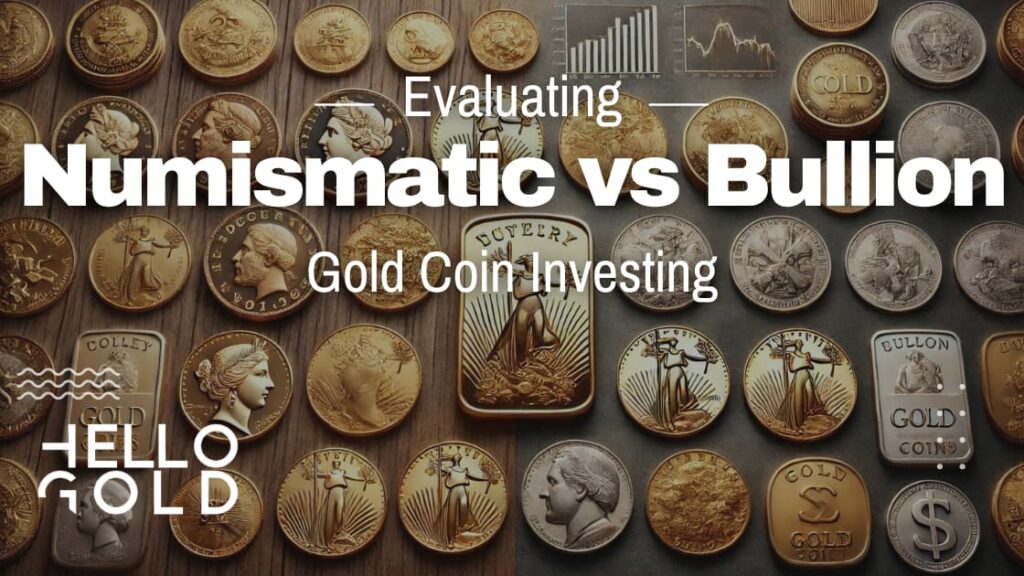Investing in gold isn’t just about following the markets. It’s about getting control of your feelings and making smarter choices when buying and selling gold.
This article gives you handy tips to handle your emotions and increase your profits, whether you’re an experienced investor or just starting with precious metals.
The Golden Rules of Investor Psychology
The gold market works on a special set of mental rules that often lead to price changes that seem unrelated to normal economic signs. Understanding these rules is key for navigating the complex world of gold investing and possibly profiting from market mistakes driven by emotional responses.
Understanding Emotions in the Gold Market
The gold market is especially affected by emotions, with fear and uncertainty being the main drivers of big price changes.
During times of economic instability or political tension, investors often turn to gold as a perceived safe place, driving up its price.
This behavior comes from a deep-rooted mental need for safety in uncertain times.
The 2008 financial crisis gives a clear example of this.
As fear took hold of global markets, gold saw a big increase in demand, doing better than many other types of investments.
This shows how emotional responses to economic events can create real market movements.
On the other hand, times of market optimism can lead to less demand for gold.
When investors feel confident about economic growth and stability, they’re more likely to go for higher-risk, higher-reward investments, moving away from gold’s perceived safety.
This back-and-forth nature of market feeling plays a crucial role in gold price movements.
Group thinking is another big factor in gold investment decisions.
As more investors buy gold in response to market fears, others may follow, creating a self-reinforcing cycle that can dramatically impact prices.
This group behavior can lead to rapid price increases or decreases, often separate from basic economic factors.
Fear of loss also plays a big role in gold market psychology. Investors tend to feel the pain of losses more strongly than the joy of gains.
This can lead to panic selling during downturns or hesitation to sell during upswings, further adding to market swings.
Recognizing this bias can help maintain a more balanced approach to gold investments.
The Safe Haven Perspective: Understanding Gold’s Perceived Value
Gold’s status as a safe investment is deeply rooted in historical and cultural views.
For centuries, gold has been seen as a store of value, especially during times of economic trouble.
This view has been strengthened by gold’s performance during major economic crises, contributing to its lasting appeal as a stable asset.
The cultural importance of gold varies across different regions and societies.
In many Asian cultures, for instance, gold is not just an investment but a symbol of wealth and prosperity, often passed down through generations.
This cultural attachment contributes to a steady demand for gold, regardless of market conditions.
Understanding these cultural differences can provide valuable insights into global gold demand patterns.
It’s important to recognize that gold’s perceived stability is often as important as its actual performance.
The belief in gold as a safe haven can become a self-fulfilling prophecy, as investors flock to it during times of uncertainty, thereby driving up its price and reinforcing its status as a reliable store of value.
This mental factor can create investment opportunities for those who can anticipate shifts in market sentiment.
Gold is often seen as a protection against inflation and currency changes. When paper money loses value due to inflation or economic instability, gold typically maintains or increases its buying power.
This feature makes it particularly attractive to investors worried about long-term economic trends and the stability of traditional currencies.
However, it’s important to note that gold investment also carries risks. Price swings can be significant, especially in the short term.
Storage and insurance costs for physical gold can eat into returns. Additionally, gold doesn’t provide income like some other investments, which can be a drawback for certain investment strategies.
To develop a mentally sound gold investment strategy, consider the following:
- Maintain a long-term view to avoid reactive decisions based on short-term market changes.
- Diversify your portfolio to balance the unique characteristics of gold with other types of investments.
- Stay informed about global economic and political events that could impact gold prices.
- Regularly reassess your investment goals and risk tolerance to ensure your gold holdings align with your overall financial strategy.
- Consider different forms of gold investment (physical gold, ETFs, mining stocks) to find the option that best suits your needs and comfort level.
The Psychology Behind Gold Price Predictions
The gold market is a complex area where psychology often plays as big a role as economic basics. Understanding the mental processes behind gold price predictions is crucial for developing effective investment strategies in this unique market.
Explore the cognitive factors affecting gold price forecasts
Several mental biases significantly influence gold price predictions, often leading to market mistakes that smart investors can use to their advantage.
Anchoring Bias:
Investors often fixate on previous price levels as reference points for future expectations.
For instance, when gold reaches a significant price point, such as $2,000 per ounce, this figure often becomes a mental anchor influencing future predictions and investment decisions.
This anchoring effect can lead to overvaluing or undervaluing gold based on past data rather than current market conditions.
To lessen this bias, it’s important to regularly reassess price expectations based on current economic indicators, world events, and supply-demand dynamics. Keeping a flexible outlook allows for more accurate assessments of gold’s true value in changing market conditions.
Recency Bias:
The tendency to give too much weight to recent events and trends can significantly impact short-term gold price predictions. This bias may cause investors to overlook longer-term patterns or fundamental factors in favor of recent market movements.
For example, a sudden increase in gold prices due to a short-term world crisis might lead to overly optimistic short-term forecasts, even if long-term basics remain unchanged.
To counter recency bias, maintain a balanced perspective by considering both short-term changes and long-term trends.
Regularly review historical data and long-term market cycles to put recent events into context within the broader market story.
Expert Opinions and Market Expectations:
Expert predictions from respected financial institutions carry considerable weight in shaping market expectations for gold prices. When institutions like Goldman Sachs predict gold prices of $2,133 per ounce in 2024, or when Citigroup and ING forecast ranges from $2,100 to $2,400, these predictions can significantly influence investor behavior and market sentiment.
While expert forecasts provide valuable insights, it’s crucial to approach them critically.
Consider the methods behind the predictions, the track record of the forecasting institution, and how these forecasts align with your own analysis of market conditions.
Remember that even expert opinions are subject to biases and limitations.
Examine the self-fulfilling nature of some gold price predictions
The gold market often shows a phenomenon known as reflexivity, where investor perceptions and actions based on predictions can change market conditions, creating a feedback loop that reinforces the original forecast.
Self-Fulfilling Prophecies:
Widely publicized forecasts can create self-fulfilling prophecies in the gold market.
If most investors believe that gold prices will rise to a certain level, their collective buying behavior can drive prices in that direction, regardless of underlying basics.
This dynamic underscores the importance of understanding market sentiment and how it can influence price movements.
For instance, if a respected analyst predicts gold will hit $3,000 per ounce, it may trigger a wave of buying that pushes the price higher, attracting more investors and further driving up the price. This cycle can continue until the prediction becomes reality, not necessarily due to changes in gold’s intrinsic value, but because of collective market behavior.
Long-Term Predictions and Market Behavior:
Long-term predictions, such as gold reaching $4,649 to $7,000 per ounce by the late 2020s or early 2030s, can have a profound impact on investment strategies and market sentiment. These forecasts, while speculative, can shape long-term investor behavior and contribute to sustained price trends.
To navigate this self-fulfilling aspect of the gold market, it’s crucial to balance an awareness of market sentiment with a solid understanding of fundamental factors. Pay attention to how widely publicized predictions are influencing investor behavior, but don’t lose sight of the underlying economic and geopolitical drivers of gold prices.
Practical Strategies for Psychologically Sound Gold Investing:
- Diversify information sources to gain a comprehensive market perspective.
- Maintain a trading journal to track decisions and the reasons behind them.
- Establish predefined entry and exit points to minimize emotional decision-making.
- Regularly reassess investment theses to ensure they’re based on sound basics rather than market hype.
- Cultivate patience, recognizing that gold is often a long-term investment.
By understanding these psychological factors influencing gold price predictions, investors can develop more nuanced and effective strategies. Remember, successful gold investing isn’t just about predicting prices accurately – it’s about understanding the complex interplay of psychology, market dynamics, and fundamental factors that drive the gold market.
Psychological Aspects That Influence Gold Investors
The gold market, like many alternative investment areas, is greatly affected by mental factors that often outweigh purely logical economic thinking. Understanding these mental aspects is key for developing good investment strategies in the intricate landscape of precious metals and other alternative investments.
Collective Behavior: When Interest in Gold Surges
Collective behavior in the gold market refers to the tendency of investors to act together, often driven by shared emotions or beliefs. This can lead to big price changes that may not always match up with basic economic factors.
The mental drivers behind group feelings in gold markets are varied, with fear and greed being the main motivators. These emotions often cause investors to rush to gold during times of economic or political trouble, a behavior rooted in the historical view of gold as a stable store of value.
For example, during the 2008 financial crisis, gold prices went up as investors looked for safety from market ups and downs. According to data from the World Gold Council, gold prices rose from $869.75 per ounce at the start of 2008 to $1,087.50 by the end of 2009, showing how shared fear can drive market trends.
Similarly, the COVID-19 pandemic triggered another jump in gold prices. Gold reached an all-time high of $2,067.15 per ounce on August 7, 2020, as economic uncertainty spread through global markets.
This price movement shows how group behavior can make market reactions to global events even stronger.
Social proof is a significant factor in shaping investment decisions in the gold market. When investors see others buying gold, it can create a snowball effect, leading to increased demand and rising prices.
This behavior was clear during both the 2008 financial crisis and the COVID-19 pandemic.
To handle these group behaviors effectively, investors should:
- Keep abreast of global economic indicators and world events that could trigger mass movements in the gold market.
- Develop a contrarian mindset, thinking about selling when everyone is buying and vice versa.
- Set clear investment goals and stick to a well-defined strategy, regardless of market hype or panic.
- Spread investments across various alternative assets to lower risks associated with herd behavior in any single market.
Confirmation Tendencies: Seeking Supporting Information
Confirmation bias greatly affects gold market analysis and investment decisions. This mental bias leads investors to look for and focus on information that confirms their existing beliefs while downplaying or ignoring opposing evidence.
In gold market research, confirmation tendencies can show up in various ways:
Selective Information Processing
Investors who are positive on gold might focus too much on news about inflation risks or world tensions, which typically support higher gold prices. On the other hand, those negative on gold might emphasize economic recovery news or rising interest rates, which could negatively impact gold prices.
Interpretation Bias
Investors may interpret unclear information in a way that supports their pre-existing views on gold. For example, a small increase in inflation might be seen as a sign of significant future inflation by gold bulls, while bears might dismiss it as a temporary change.
Selective Recall
Investors tend to remember information that supports their views on gold more easily than contradictory information. This can lead to a skewed view of market trends and potential opportunities.
The tendency to prioritize information aligning with existing beliefs can lead to flawed decision-making. For instance, an investor convinced of an upcoming economic crisis might overlook positive economic indicators, potentially missing opportunities in other investment areas or overexposing themselves to gold.
To reduce the impact of confirmation bias on gold investments:
- Actively seek out diverse viewpoints and conflicting information. Read analyses from both gold bulls and bears.
- Regularly challenge assumptions by asking, “What if my current belief about gold is wrong?”
- Use data-driven analysis. Look at objective indicators like interest rates, inflation figures, and currency strength rather than relying solely on market sentiment.
- Consider working with a financial advisor who can provide an objective perspective on your gold investment strategy.
- Implement a systematic review process for investment decisions, incorporating both supporting and contradicting evidence.
By understanding and actively managing these mental aspects, investors can make more informed and balanced decisions in their gold investments and broader alternative investment strategies.
Learning from History: Gold Market Case Studies
Looking at past gold market events gives important insights for those interested in alternative investments. By studying how markets behaved before, investors can create better plans to handle future trends.
Two key events that shaped the precious metals landscape were the global economic downturn of 2008 and the 2011 gold rally. These case studies teach valuable lessons about market behavior, investor thinking, and how gold fits into a varied investment portfolio.
The 2008 Financial Crisis: Increased Interest in Gold
The 2008 financial crisis was a turning point for gold investments. As global economic uncertainty grew, gold became seen as stable. Gold prices went up a lot during this time, with investors looking for safety from falling stock markets and other investments.
This big change was caused by several connected factors:
- Economic Uncertainty
- Stock Market Ups and Downs
- Currency Worries
- Central Bank Actions
Economic uncertainty played a big role in pushing investors towards gold.
The failure of major banks and the following economic downturn made people run to what they saw as safe.
Gold, known for keeping its value over time, became attractive for careful investors trying to protect their money during tough times.
The stock market’s big swings made gold look even better. As stock prices fell, gold’s tendency to move opposite to stocks became clear.
Data from the time shows that while major stock indexes fell a lot, gold prices stayed strong, going up about 6% during the worst of the financial crisis.
This big difference reinforced gold’s reputation as a reliable hedge and a way to spread out risk.
Currency worries also helped gold’s rise.
Government help and bailouts made people fear that currencies might lose value, leading investors to look for alternatives to regular money.
Gold, priced in U.S. dollars, benefited from these worries as investors tried to protect their wealth from possible inflation.
Central bank actions further boosted gold’s appeal.
New monetary policies, including printing more money, were used to stabilize economies.
These actions raised concerns about future inflation and currency weakening, making gold an attractive hedge against these potential risks.
How gold did during this time was especially noteworthy compared to other investments.
While many traditional investments lost a lot, gold not only kept its value but went up.
This showed gold’s ability to provide stability during economic trouble and act as a protection against currency changes and inflation pressures.
For investors, the 2008 crisis showed the importance of including gold in a varied portfolio. It demonstrated the precious metal’s capacity to serve as a safeguard during times of market stress and economic uncertainty.
Nonetheless, investors should remember to keep a balanced approach, as having too much of any one investment can increase risk.
The 2011 Gold Rally: When Enthusiasm Peaks
The gold market reached its highest point in 2011, with prices soaring to never-before-seen levels. This rally was driven by a mix of market forces and investor thinking. The key factors fueling this unprecedented rise included:
- Lingering Effects of the 2008 Crisis
- Government Debt Worries
- Inflation Fears
- Market Speculation
- Media Influence
The aftermath of the 2008 financial crisis continued to support gold prices, as investors remained cautious about traditional financial assets. This ongoing uncertainty provided a solid base for gold’s continued rise.
At the same time, worries about the European debt crisis and the U.S. debt ceiling debate increased demand for gold as a protection against possible government defaults, further driving prices up.
Inflation fears were a significant catalyst in the rally. Continued loose monetary policies around the world stoked apprehensions about eroding purchasing power, prompting investors to flock to gold as a trusted safeguard against rising prices.
As prices rose, speculative buying increased, setting off a chain reaction that propelled gold to unprecedented levels.
Media coverage amplified market sentiment during this period, contributing to the price surge.
Headlines praising gold as the ultimate safe haven and predictions of even higher prices created a buying frenzy.
This media-driven enthusiasm created an echo chamber effect, where positive sentiment fed into itself, driving prices ever higher.
This peak enthusiasm also set the stage for a later drop.
As prices reached record highs, some investors began to question if the rally could last.
When sentiment shifted, the correction was quick and significant, with gold prices falling substantially from their peak in the following years.
The 2011 rally offers critical lessons for alternative investment strategies. It highlights the importance of being careful about extreme optimism in any market.
When sentiment becomes overwhelmingly positive, it’s often a signal to reassess positions and consider potential risks. Understanding what drives markets is crucial; investors should recognize the factors driving prices and assess if they can last long-term.
In the case of the 2011 rally, many of the driving factors were temporary or based on speculation.
Even in times of high enthusiasm, it’s essential not to ignore the basics.
The rapid price increase in 2011 outpaced fundamental factors, creating an unsustainable situation.
This underscores the importance of keeping a balanced perspective and not getting caught up in short-term market excitement.
These historical case studies provide valuable insights for investors considering gold or other alternative investments.
They show the complex interplay of economic factors, investor psychology, and market dynamics that can drive asset prices.
By studying these events, investors can develop a more nuanced understanding of gold market behavior and use this knowledge to inform their investment decisions.
Reading the Gold Market’s Sentiment
Gold prices often change based on feelings as much as facts, making mood analysis a useful tool for investment planning.
Key Indicators of Market Sentiment
Several tools and measures are particularly helpful for checking the mood of the gold market:
The VIX, or Volatility Index, often called the “fear index,” offers valuable insights into overall market mood.
While not directly tied to gold, there’s often a link between increased market swings and rising gold prices.
During times of high volatility, gold often serves as a safe place, attracting investors looking for stability.
Put/call ratios in the gold options market provide another important view on market mood.
A high put/call ratio might show negative feelings, potentially signaling a good time to consider buying. On the other hand, a low ratio could suggest positive feelings, possibly indicating a selling opportunity.
It’s important to view these ratios along with other signs and overall market conditions for a full analysis.
The Commitment of Traders (COT) report is a valuable source of mood data. It provides key information on the positions of various market players.
The net positions of large speculators are particularly noteworthy. Big net long positions often indicate positive mood, while substantial net short positions might suggest negative mood.
However, extreme positions in either direction can sometimes signal a potential market reversal.
Gold ETF holdings serve as another key mood indicator.
Big inflows into gold ETFs often signal positive feelings and growing interest in gold as an investment.
On the flip side, steady outflows may indicate waning interest or negative feelings.
Watching these trends over time can help identify shifts in investor attitudes towards gold.
The Social Media Effect: Navigating the Information Flow
In the digital age, social media has become a big force in shaping gold market mood. The quick spread of information-and misinformation-through platforms like Twitter, Reddit, and financial forums can cause swift shifts in market views and, as a result, gold prices.
To effectively navigate this information flow:
Watch trending topics and hashtags related to gold on major social platforms. These can provide real-time insights into market views.
However, one must exercise caution when interpreting this information, as social media mood can be manipulated or may not always reflect wider market realities.
Follow trusted financial experts and influencers, but do so with a critical eye. Their analyses and predictions can sway mood, especially among everyday investors.
Evaluate their credibility, track record, and potential biases before using their views in investment decisions.
Use social media as an extra tool, not a replacement for traditional mood indicators and basic analysis. While it can provide valuable real-time insights, it should be considered alongside other data points for a complete view of market mood.
Be aware of the echo chamber effect on social media. Algorithms often show users content that matches their existing views, potentially skewing perception of overall market mood.
Actively seeking out diverse perspectives is essential to maintain a balanced view.
Pay attention to the speed and reach of information spread on social media. Information about gold can influence market mood quickly, potentially creating short-term market movements.
Central Bank Actions and Market Psychology
Central bank policies play a key role in shaping the landscape of alternative investments, particularly in the gold market.
Their decisions spread through the financial world, influencing investor feelings and driving big price movements in precious metals.
Understanding how central bank actions impact gold prices is essential for developing strong investment strategies in this sector.
Examine how central bank policies influence gold investor sentiment
Interest rate decisions stand as a main tool in the central bank toolkit, having a big influence over gold prices.
When central banks lower interest rates, it typically raises inflation concerns and reduces the appeal of yield-bearing assets. This scenario often leads investors to view gold as a safeguard against potential currency weakness.
The Federal Reserve’s near-zero interest rate policy following the 2008 financial crisis serves as a prime example of this dynamic. During this period, gold prices experienced a significant rally, reaching record highs in subsequent years.
Statistics compiled by gold industry analysts corroborate this observation.
The yellow metal’s value surged from its starting price of $869.75 at the onset of 2008 to a striking $1,087.50 as the subsequent year drew to a close, marking an increase of approximately 25.04%.
This substantial price movement underscores the profound impact that central bank policies can have on the gold market.
Conversely, when interest rates rise, the opportunity cost of holding non-yielding assets like gold increases. This can potentially dampen gold’s appeal, especially when compared to interest-bearing investments.
However, it’s crucial to note that the relationship between interest rates and gold prices isn’t always straightforward. Market expectations and the pace of rate changes can sometimes lead to unexpected price movements, highlighting the complexity of this relationship.
Quantitative easing (QE) programs represent another potent instrument in the monetary authority’s arsenal that can dramatically shift perceptions of gold’s value.
These large-scale asset purchase programs often lead to increased liquidity in financial markets, which can fuel concerns about future inflation.
The psychological impact of quantitative easing on investor sentiment frequently outweighs its direct economic effects, emphasizing the critical role of market psychology in gold price movements.
The extensive quantitative easing programs implemented by major central banks in response to the COVID-19 pandemic provide a recent and striking example of this phenomenon.
As central banks flooded markets with liquidity, gold prices surged, climbing to unprecedented levels and peaking at over $2,000 per ounce in early August 2020.
This price movement reflects investors’ rush to embrace gold as a trusted shelter amid unprecedented economic uncertainty and potential inflationary pressures.
Central bank gold purchases play a crucial role in shaping market narratives and investor psychology.
When central banks, particularly those of emerging economies, increase their gold reserves, it sends a powerful signal to the market about gold’s enduring value.
These purchases can boost investor confidence in gold as a strategic asset, potentially sparking a surge in market interest and driving prices upward.
The psychological impact of central bank gold purchases often extends beyond their actual market impact, influencing long-term perceptions of gold’s role in the global financial system. For instance, the significant gold purchases by Russia and China in recent years have not only supported gold prices but also sparked discussions about the changing dynamics of global reserve currencies.
To navigate this complex landscape effectively, alternative investment seekers should consider the following strategies:
- Keep a close eye on central bank communications and policy decisions, particularly those of major economies like the U.S., Eurozone, and China.
- Develop a systematic approach to analyzing the potential inflationary impact of monetary policies and consider gold’s role as an inflation hedge within a diversified portfolio.
- Track central bank gold purchases and sales, as these offer a window into long-term trends in the gold market.
- Consider the broader economic context when interpreting central bank actions, as the impact on gold prices can vary depending on overall market conditions.
- Diversify alternative investment portfolios beyond gold to reduce risks associated with monetary policy changes.
By developing a nuanced understanding of the relationship between central bank actions and gold market dynamics, investors can craft more astute strategies for incorporating gold into their alternative investment portfolios.
While central bank policies significantly influence gold prices, they represent just one piece of a complex puzzle.
A comprehensive approach considering multiple factors will yield the most robust investment strategy in the ever-changing landscape of alternative investments.
Building Your Psychological Edge in Gold Investing
Success in gold investing goes beyond market knowledge, including key mental factors that can greatly impact investment results. Developing a psychological edge is vital for maneuvering through the intricate landscape of the gold market, where emotions often drive price changes as much as economic basics.
Independent Thinking: The Power of Unique Perspectives
Independent thinking is a key part of successful gold investing. It allows investors to spot opportunities that others might miss and avoid common mistakes driven by what most people think.
The ability to form well-reasoned opinions based on thorough analysis, rather than following the crowd, can lead to better entry and exit points in gold investments.
Developing independent thinking in gold investing involves several key strategies:
- Investors should carefully evaluate popular market ideas, looking for evidence to support or disprove them. This approach helps in spotting potential market mistakes and opportunities.
- Looking at a wide range of opinions, including those that go against the norm, provides a full market view. This practice helps in avoiding echo chambers that can strengthen biased viewpoints.
- Making a systematic approach to evaluating gold investments based on unique insights and risk tolerance can give you an edge. This method might combine technical analysis with basic factors such as inflation rates, currency movements, and world events.
- For those in investment groups, creating an environment where team members feel comfortable sharing different views can lead to stronger investment decisions.
The 2011 gold rally is a good example of why independent thinking matters. During this time, gold prices soared to unprecedented levels, peaking at $1,895 per ounce.
Investors who kept their own analysis amid market excitement were better positioned to see that the price surge couldn’t last. These investors were able to profit from the following price drop, showing the value of thinking beyond what most people believe.
Emotional Balance: Your Key to Consistent Performance
Emotional balance is crucial for maintaining steady performance in gold investing.
The ups and downs of the gold market can trigger strong emotions, potentially leading to hasty decisions that go against established investment strategies.
Mastering emotional control is essential for making clear and rational judgments, especially during times of market turmoil.
Achieving emotional balance in gold investing hinges on mastering several key practices:
- Mindfulness and meditation: Regular mindfulness practices can greatly improve an investor’s ability to stay calm under pressure. Even short daily meditation sessions can enhance decision-making abilities in high-stress market situations.
- Structured decision-making processes: Developing a checklist or framework for investment decisions can help reduce emotional influence. This might include assessing current market conditions, evaluating portfolio allocation, and considering long-term effects of each trade.
- Clear investment goals: Defining specific, measurable objectives for gold investments provides anchors during market turmoil. For instance, keeping a certain percentage of a portfolio in gold as a hedge against inflation or currency changes can serve as a guiding principle.
- Stress management techniques: Using methods such as deep breathing exercises or physical activity can help manage stress during market volatility. These practices can lower stress hormone levels and improve decision-making abilities.
- Trading journal maintenance: Regularly reflecting on investment decisions and their outcomes enhances self-awareness and helps identify emotional patterns that may influence trading behavior.
- Recognizing emotional decision-making: It’s crucial to be aware of strong urges to buy or sell based on market news or price movements. In such situations, referring back to predefined investment criteria can help ensure decisions align with long-term strategies rather than short-term emotions.
By developing independent thinking and maintaining emotional balance, investors can cultivate a psychological edge that serves them well in the complex realm of gold and silver trading. This mental strength allows for capitalizing on market mistakes, maintaining discipline during volatile periods, and making decisions aligned with long-term investment goals.
Crafting a Psychologically Sound Gold Investment Strategy
Creating a strong gold investment strategy requires more than just market knowledge. It needs a deep understanding of the mental factors that influence investment decisions.
A well-crafted strategy aims to maximize returns while effectively managing the emotional challenges often linked with precious metal investments.
Key components of a robust gold investment plan
Gold’s unique properties make it a powerful tool for spreading out investments. Its low connection with other financial assets can help lower overall portfolio risk and potentially boost returns.
Asset Allocation and Portfolio Diversification
When deciding how much gold to include, investors should consider their risk tolerance, investment goals, and current market conditions. While there’s no one-size-fits-all approach, many financial experts suggest putting between 5% to 10% of a portfolio into gold.
The mental benefit of adding gold to a portfolio lies in its reputation as a safe-haven asset. During times of market unrest or economic uncertainty, having gold in a portfolio can provide a sense of security and help prevent hasty decisions in other areas of investment.
Setting Realistic Return Expectations
Understanding gold’s past performance is crucial for setting realistic return expectations and keeping emotional balance during market changes.
Gold has shown its ability to preserve wealth over long periods and often does well during times of economic stress.
However, investors should bear in mind that gold prices can be unpredictable in the short term.
During the global economic turmoil of 2008-2009, gold prices showed significant ups and downs.
At first, gold prices dropped sharply following the Lehman Brothers collapse, reaching a low of around $692.50 per ounce in November 2008.
However, as the crisis unfolded and investors looked for safe-haven assets, gold prices bounced back strongly. By October 2010, gold had risen to $1,300 per ounce, showing its resilience and appeal as a hedge against financial uncertainty.
From a mental perspective, setting realistic expectations helps prevent disappointment and worry that can lead to poor investment decisions.
It’s crucial to view gold’s value mainly in its role as a portfolio stabilizer rather than a high-growth asset.
This view allows for a more balanced emotional approach to overall investment strategy.
Regular Portfolio Rebalancing
Market movements can cause asset allocation to drift from target percentages over time.
Regular rebalancing is not just a mechanical process-it’s a mental tool that helps maintain discipline in investment approach.
By systematically selling assets that have become overweighted and buying those that have become underweighted, investors essentially force themselves to buy low and sell high, countering natural emotional tendencies that often lead to suboptimal decisions.
For gold investments, consider rebalancing when allocation moves beyond a certain threshold from the target.
Some experts suggest rebalancing at fixed time intervals or when a component strays from its original weight beyond a certain threshold (e.g., 5% or 10%).
This approach helps capitalize on gold’s price changes while maintaining the desired risk profile.
The act of rebalancing can also serve as a regular check-in on investment strategy, allowing for reassessment of goals and adjustment of approach if necessary.
Choosing the Right Investment Vehicles
The method of investing in gold can significantly impact the mental approach to the investment.
Physical gold offers a tangible asset that some investors find mentally reassuring. However, it comes with storage and insurance costs that can create additional considerations.
Gold ETFs and mutual funds provide ease of trading and professional management, which can lessen some of the mental burden of making individual investment decisions. On the other hand, gold mining stocks offer potential for higher returns but come with increased unpredictability that can test an investor’s emotional resilience.
It’s important to consider personal mental tendencies when choosing a gold investment vehicle.
If the idea of owning physical gold brings peace of mind, it may be worth the additional costs.
If a more hands-off approach is preferred, ETFs or mutual funds might be more suitable.
Market Monitoring and Continuous Education
Keeping abreast of market dynamics, global developments, and inflationary patterns is crucial for making informed decisions about gold investments. However, it’s equally important to develop the mental discipline to distinguish between important information and market noise.
Continuous education about gold markets and investment strategies is essential. A deeper understanding of the factors that influence gold prices and the metal’s role within the broader economic landscape equips investors to make rational decisions and avoid emotional reactions to market events.
Reflections
Investing in gold takes controlling your feelings and knowing the market. Smart investors think on their own, stay calm, and make plans that match their goals.
Keep your hopes realistic, spread out where you put your money, and keep up with changes in the market. Don’t let emotions guide your choices.
Take action now: check your current plan, think about adding gold to protect your cash, and keep learning about new ways to invest.
How much money you’ll have in the future depends on what you do today.











